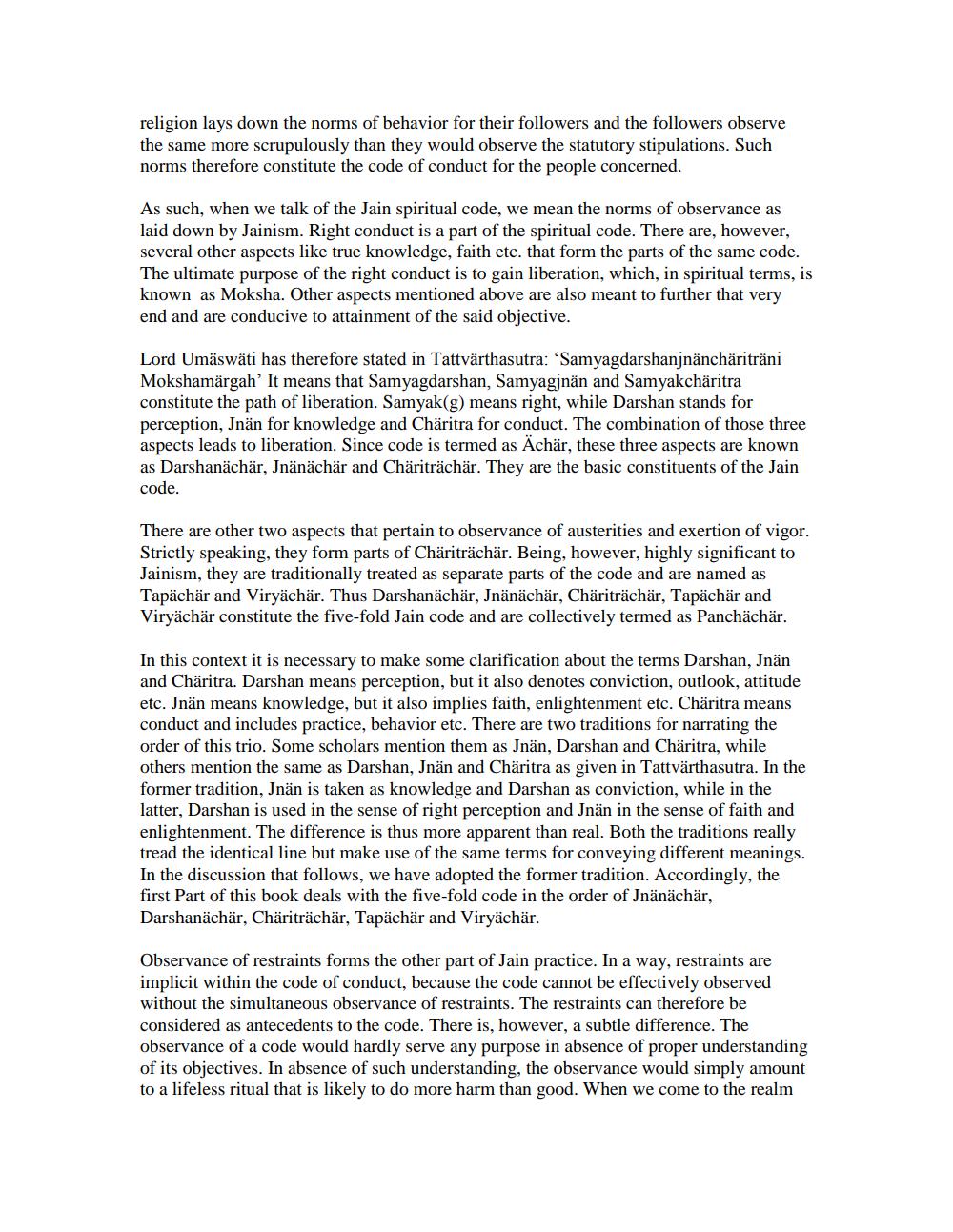Book Title: Spiritual Code and Restraints Author(s): Manu Doshi Publisher: Manu Doshi View full book textPage 3
________________ religion lays down the norms of behavior for their followers and the followers observe the same more scrupulously than they would observe the statutory stipulations. Such norms therefore constitute the code of conduct for the people concerned. As such, when we talk of the Jain spiritual code, we mean the norms of observance as laid down by Jainism. Right conduct is a part of the spiritual code. There are, however, several other aspects like true knowledge, faith etc. that form the parts of the same code. The ultimate purpose of the right conduct is to gain liberation, which, in spiritual terms, is known as Moksha. Other aspects mentioned above are also meant to further that very end and are conducive to attainment of the said objective. Lord Umäswäti has therefore stated in Tattvärthasutra: 'Samyagdarshanjnänchäriträni Mokshamärgah' It means that Samyagdarshan, Samyagjnän and Samyakchäritra constitute the path of liberation. Samyak(g) means right, while Darshan stands for perception, Jnän for knowledge and Chäritra for conduct. The combination of those three aspects leads to liberation. Since code is termed as Achär, these three aspects are known as Darshanächär, Jnänächär and Chariträchär. They are the basic constituents of the Jain code. There are other two aspects that pertain to observance of austerities and exertion of vigor. Strictly speaking, they form parts of Chariträchär. Being, however, highly significant to Jainism, they are traditionally treated as separate parts of the code and are named as Tapächär and Viryächär. Thus Darshanächär, Jnänächär, Chariträchär, Tapächär and Viryächär constitute the five-fold Jain code and are collectively termed as Panchächär. In this context it is necessary to make some clarification about the terms Darshan, Jnän and Chäritra. Darshan means perception, but it also denotes conviction, outlook, attitude etc. Jnän means knowledge, but it also implies faith, enlightenment etc. Chäritra means conduct and includes practice, behavior etc. There are two traditions for narrating the order of this trio. Some scholars mention them as Jnän, Darshan and Chäritra, while others mention the same as Darshan, Jnän and Chäritra as given in Tattvärthasutra. In the former tradition, Jnän is taken as knowledge and Darshan as conviction, while in the latter, Darshan is used in the sense of right perception and Jnän in the sense of faith and enlightenment. The difference is thus more apparent than real. Both the traditions really tread the identical line but make use of the same terms for conveying different meanings. In the discussion that follows, we have adopted the former tradition. Accordingly, the first Part of this book deals with the five-fold code in the order of Jnänächär, Darshanächär, Chäriträchär, Tapächär and Viryächär. Observance of restraints forms the other part of Jain practice. In a way, restraints are implicit within the code of conduct, because the code cannot be effectively observed without the simultaneous observance of restraints. The restraints can therefore be considered as antecedents to the code. There is, however, a subtle difference. The observance of a code would hardly serve any purpose in absence of proper understanding of its objectives. In absence of such understanding, the observance would simply amount to a lifeless ritual that is likely to do more harm than good. When we come to the realmPage Navigation
1 2 3 4 5 6 7 8 9 10 11 12 13 14 15 16 17 18 19 20 21 22 23 24 25 26 27 28 29 30 31 32 ... 69
